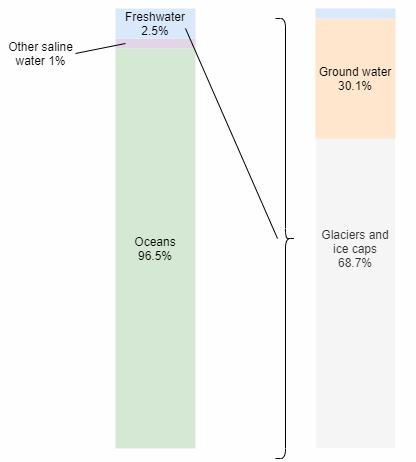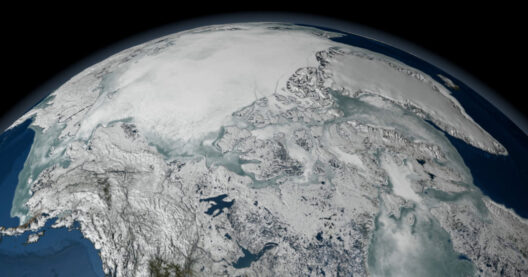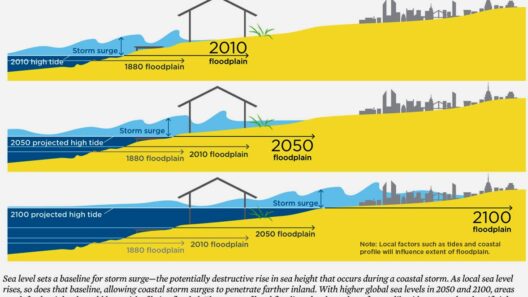The phenomenon of rising sea levels is one of the most pressing issues attributable to climate change. As the earth’s temperature rises, several complex processes catalyze the increase in seawater levels, significantly impacting ecosystems and human societies alike. Understanding the factors behind this unsettling trend is paramount to developing effective strategies to mitigate its consequences.
Several primary contributors have been identified, and they can be broadly categorized into thermal expansion of seawater, melting glaciers and polar ice sheets, and alterations in terrestrial water storage. Each of these factors plays a distinct role in the dynamic system that governs global sea levels.
Understanding Thermal Expansion: The Invisible Culprit
One of the most crucial factors driving rising sea levels is thermal expansion. As ocean water heats up due to climate change, it begins to expand. The laws of thermodynamics dictate that as a substance’s temperature increases, it occupies more space. This expansion is particularly significant in the world’s oceans, which absorb about 93% of the excess heat generated by greenhouse gas emissions.
The consequences are alarming. Estimates indicate that thermal expansion contributes around 30% of the total sea level rise observed in the past century. As temperatures continue to rise, we can expect this contribution to increase, exacerbating the situation further. Coastal systems, including wetlands and estuaries, face imminent threats as the expanding ocean encroaches on land, leading to erosion and the submergence of vital habitats.
The implications of this thermal activity extend beyond mere physical changes. They also influence ocean circulation patterns, alter weather systems, and affect marine biodiversity. This interconnected nature of climate components highlights the urgent need for comprehensive climate action.
Glacial Melting: The Loss of Cryospheric Inventory
Equally significant in the rise of sea levels is the accelerated melting of glaciers and ice sheets, particularly in Greenland and Antarctica. Glacial melting, driven by rising global temperatures, is releasing vast quantities of freshwater into the oceans. This process is alarming, as the Greenland Ice Sheet holds enough ice to raise global sea levels by approximately 7 meters if completely melted. The Antarctic Ice Sheet, the largest single mass of ice on Earth, could add over 58 meters to sea levels if all its ice were to melt.
Research indicates that melting rates for both the Greenland and Antarctic ice sheets have increased significantly over the past few decades. In Greenland, the annual ice loss has tripled since the early 2000s, primarily due to surface melting and ice discharge into the ocean. Meanwhile, Antarctica has witnessed similar alarming trends, with glaciers retreating at unprecedented rates.
The freshwater influx from glacial melting not only contributes directly to rising sea levels but also affects oceanic salinity and circulation. The potential destabilization of the Gulf Stream, a crucial ocean current that affects climate patterns across the globe, could have far-reaching consequences. This interconnected web of climatic influences underscores the urgent need to address greenhouse gas emissions as the primary driver of climate change.
Terrestrial Water Storage: The Hidden Reservoir
In addition to thermal expansion and glacial melting, changes in terrestrial water storage play a critical yet often overlooked role in sea level rise. This category encompasses a range of human and natural factors, including groundwater depletion, dam construction, and shifts in reservoirs due to changes in land use.
Groundwater extraction for agriculture and urban use has led to significant reductions in underground water reserves. When groundwater is depleted, it often results in a decrease in the natural storage capacity of water within terrestrial systems, causing more water from rivers and lakes to flow into the ocean. Furthermore, the construction of dams alters natural water flow, leading to both localized increases in water volume and global repercussions as stored water is eventually released into the sea.
Natural factors also play a part in terrestrial water dynamics. For example, prolonged droughts can reduce storage capacities and increase direct runoff into the ocean. As climate change continues to influence precipitation patterns, we may see more erratic hydrological cycles, further complicating the picture of sea level changes.
Long-term Consequences: A Call to Action
The ramifications of rising sea levels are vast, affecting millions of people worldwide. Coastal communities are particularly vulnerable, facing increased flooding, habitat loss, and heightened storm surges. Furthermore, the socioeconomic implications are profound, with potential displacement of populations, loss of livelihoods, and increased strain on infrastructure.
Immediate and sustained action is required to curb the factors behind rising sea levels. Mitigation strategies must focus on reducing greenhouse gas emissions to slow global warming, alongside protective measures for vulnerable coastal areas. Through collaborative efforts at local, national, and international levels, we can address the multifaceted challenges posed by rising sea levels.
In conclusion, rising sea levels represent a complex interplay of various environmental processes, of which thermal expansion, glacial melting, and terrestrial water storage changes are pivotal. Each of these factors articulates the urgent need for comprehensive climate policies and proactive strategies to protect vulnerable ecosystems and communities. Understanding these elements empowers individuals and policymakers to take meaningful steps toward a sustainable future.







